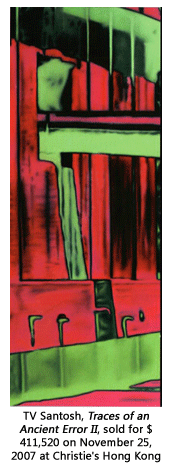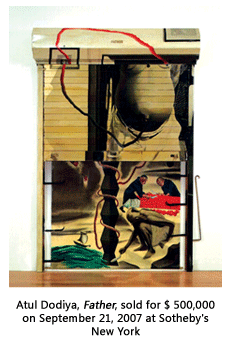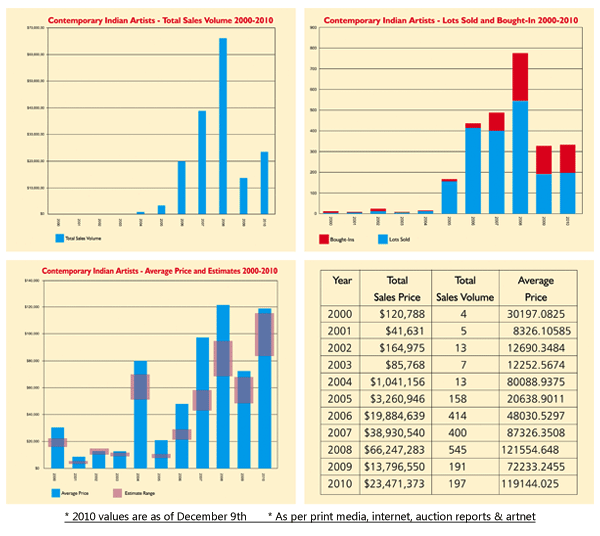- Prelude
- Editorial
- Subodh's 'return home'
- A Conversation with TV Santosh
- It's a War Out There
- Raqib Shaw
- Illusions in Red from a very British Indian Sculptor
- Stand Alone: Shibu Natesan
- Reading Atul Dodiya
- Bharti Kher: An Obsession for Bindis
- Bose Krishnamachari
- The Image - Spectacle and the Self
- From Self-depiction to Self-reference: Contemporary Indian Art
- GenNext: The Epitome of New Generation Art
- Kolkata's Contemporary Art A Look in the Mirror
- Innovation Coalesced with Continuing Chinese Qualities
- Kala Bhavana-Charukala Anushad Exchange Program
- Montblanc Fountain Pens
- Dutch Designs: The Queen Anne Style
- Bangalore Dance Beat
- Decade of change
- Distance Between Art & It's Connoisseur
- What Happened and What's Forthcoming
- 3rd India Art Summit
- New Paradigms of the Global Language of Art
- Black Brown & The Blue: Shuvaprasanna
- Art Events Kolkata
- Musings from Chennai
- Art Bengaluru
- Printmaker's Season
- Mumbai Art Sighting
- The Pause of Profound Stillness
- Previews
- In the News
- The Rebel Queen: An icon of her own times yet looked down upon
ART news & views
Decade of change
Volume: 3 Issue No: 14 Month: 3 Year: 2011
Market Monitor
by Art Bug
Wonder of wonders!
 Despite setting records in 2010 as the highest sold Indian artist, Sayed Haider Raza or even his close second Francis Newton Souza do not by any way come among the first five Indian modern artists, in terms of continuity on the top market bracket, when looked at from the perspective of the last decade.
Despite setting records in 2010 as the highest sold Indian artist, Sayed Haider Raza or even his close second Francis Newton Souza do not by any way come among the first five Indian modern artists, in terms of continuity on the top market bracket, when looked at from the perspective of the last decade.
The five top bracket players who emerge are Anish Kapoor, Subodh Gupta, Atul Dodiya, TV Santosh and Raqib Shaw.
A study of their graph (graph1) presents quite a few financial anecdotes. While Kapoor has registered  on the international scene right from 2000, and is still going strong, Dodiya, comes third in the list started off two years later in 2002. On the other hand, Gupta, who is second, did not even have an international registry as late as 2005, when he sold at $129, 103.61. It was the same year that Santosh and Shaw's works were also taken note of by the global collectors, who registered at $80,524.27 and $90.23 respectively. In the same year, Dodiya rode the highest crest at $538,758.59, leaving a lot to be desired from his more veteran (in the international circuit) colleague, Kapoor, who clocked $397, 263.09.
on the international scene right from 2000, and is still going strong, Dodiya, comes third in the list started off two years later in 2002. On the other hand, Gupta, who is second, did not even have an international registry as late as 2005, when he sold at $129, 103.61. It was the same year that Santosh and Shaw's works were also taken note of by the global collectors, who registered at $80,524.27 and $90.23 respectively. In the same year, Dodiya rode the highest crest at $538,758.59, leaving a lot to be desired from his more veteran (in the international circuit) colleague, Kapoor, who clocked $397, 263.09.
An interesting bit here: It was also in 2005, that a painting by an Indian modern master broke the $1 million mark. Tyeb Mehta's Mahishasura sold for $1.58 million at a Christie's auction in New York.
One can safely assume that 2005 was the landmark year for Indian modern artists bursting upon the international scenewith five stalwarts making their mark.
Why so?
 Writing on the decade in Indian art titled The decade in Art in a January 2011 issue of the well-known Indian daily, The Hindustan Times, Anindita Ghose tries to find out a few reasons. But before quoting her, let us note that despite Sotheby's holding its first dedicated sale of Indian art in 1995, it took close to a decade for Indian modern masters to really burst upon the Indian scene.
Writing on the decade in Indian art titled The decade in Art in a January 2011 issue of the well-known Indian daily, The Hindustan Times, Anindita Ghose tries to find out a few reasons. But before quoting her, let us note that despite Sotheby's holding its first dedicated sale of Indian art in 1995, it took close to a decade for Indian modern masters to really burst upon the Indian scene.
Ghose writes, “Between 2000 and 2010, the auction market for Indian art shot up from around $5 million to an estimated $85 million. The start of the decade also marked the launch of Saffronart, India's largest auction house, which rapidly elbowed its way onto the scene alongside established international veterans such as Christie's and Sotheby's. Several factors underwrote the growth of the Indian art bazaar: the Indian economy, the new affluence of its population, and the global interest in the “India story”, of which art was the newfangled frontier.”
True, the Indian economy, the Indian art bazaar, the affluence of its population etc. were responsible. But it was also during this time that the new creature, called the Indian art collector emerged upon the scene. Ghose writes, “Up until this decade, serious collectors of Indian art such as Emmanuel Schlesinger and Charles Herwitz had been European or American. Collectors such as Anupam Poddar, Kiran Nadar and Rajshree Pathy are promising additions functioning outside the market realm. Poddar's 7,500 sq. ft non-profit Devi Art Foundation is in effect India's first contemporary art museum. And the good news is that the Indian government is working to make this sort of philanthropy tax efficient.”
At the same time, the duopoly, namely Christie's and Sotheby's became even more aggressive in their promotion of Indian modern art, dedicating more and more auction time to Indian contemporary art sales. The result of this reached full fruition around 2008, when Indian art outsold an estimated range of $60,000 to $100,000 by just about crossing the $120,000 mark. However, this was just before the meltdown, and since then a lot of correction has happened in the market.
While in 2008, Gupta clocked $15, 972, 965.79 (naturally his highest in the last decade), by 2010, he has come down to $8, 964, 023.73. Other than Dodiya, the other three in the top five bracket also went through a boom in 2008, only to fall drastically once the meltdown caught up with them in 2009, and then again to reach the correction stage last year (See chart 1). Dodiya though reached his peak a year back, in 2007, but still took a serious beating in 2009, when one compares his $2,083,974.43 and $95,931.11 in the two consecutive years, namely  2008 and 2009. By the way, it is also worth mentioning that it was in the boom year of 2008 that India got its first international art fair. The Indian Art Summit, 2011 was graced by the presence of Anish Kapoor.
2008 and 2009. By the way, it is also worth mentioning that it was in the boom year of 2008 that India got its first international art fair. The Indian Art Summit, 2011 was graced by the presence of Anish Kapoor.
However, the boom had its upside for the artists. It spurred ambition. Subodh Gupta became the first Indian artist to have his name recognized across the globe. He participated in prestigious charity events such as Bono's RED Campaign. This wasn't a one-off occasion. In the past few years, there hasn't been a Biennale that hasn't featured him- from Art Basel to the Venice Biennale, and other fairs in London, Paris, Zurich, Brisbane and Seoul.
 Other artists such as Atul Dodiya, Jitish Kallat and T V Santosh acquired an artistic vocabulary that took them to the international collector. Their art was getting bigger too, forcing galleries to step up curatorial practices and ramp up their spaces. Ghose gives a few examples: “Gallery Chemould in Mumbai, one of the country's oldest showcases for contemporary Indian art, moved to a larger space in 2007. Several new galleries- Project 88 and Chatterjee and Lal in Mumbai, Galleryske in Bangalore were founded. New magazines of art news and criticism such as Art India and Art & Deal flourished. Jawaharlal Nehru University in New Delhi instituted art history graduate courses that are producing a new generation of museologists and art critics.”
Other artists such as Atul Dodiya, Jitish Kallat and T V Santosh acquired an artistic vocabulary that took them to the international collector. Their art was getting bigger too, forcing galleries to step up curatorial practices and ramp up their spaces. Ghose gives a few examples: “Gallery Chemould in Mumbai, one of the country's oldest showcases for contemporary Indian art, moved to a larger space in 2007. Several new galleries- Project 88 and Chatterjee and Lal in Mumbai, Galleryske in Bangalore were founded. New magazines of art news and criticism such as Art India and Art & Deal flourished. Jawaharlal Nehru University in New Delhi instituted art history graduate courses that are producing a new generation of museologists and art critics.”
But how did the market correct itself?
Ghose writes, “At the peak of the meltdown in March 2009, the aggregate of sales of the three auction houses for Indian art (Christie's, Sotheby's and Saffronart) was under $5 million. In the summer of 2008, this figure had been $21.4 million.
But pundits saw virtue in this debacle. When the bubble burst, it shifted the collectors from the speculators. The art world brought back that crucial connect between artistic achievements and prices that had gone haywire during the boom.”
This therefore has been the story of Indian art over the past decade, and as indications show, 2011 onwards, it is all set to achieve better feats.
